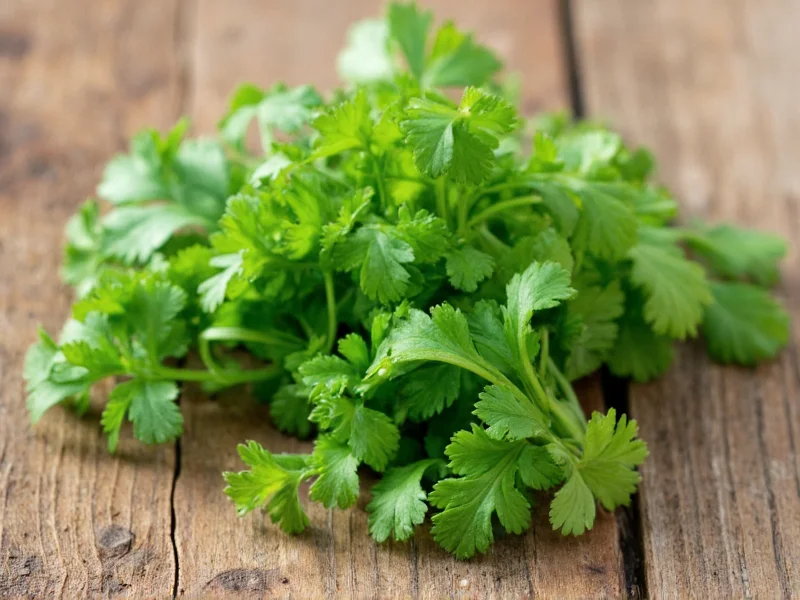Understanding the differences between cilantro and parsley is essential for home cooks and professional chefs alike. These two herbs often cause confusion due to their similar leaf structures, but their culinary applications couldn't be more different. Let's explore everything you need to know about cilantro versus parsley to elevate your cooking.
Visual Identification: Telling Cilantro and Parsley Apart
At first glance, cilantro (Coriandrum sativum) and parsley (Petroselinum crispum) appear similar, but key visual differences exist. Flat-leaf parsley has broader, darker green leaves with serrated edges that lie relatively flat. Curly parsley features ruffled, crinkled leaves that form a more compact shape. Cilantro leaves are more rounded with a delicate, lacy appearance and tend to grow more upright on the stem.
When examining the stems, cilantro typically has thinner, more delicate stems that are often purplish at the base, while parsley stems are thicker and more rigid. The leaf veins of cilantro form a more pronounced triangular pattern compared to parsley's less defined venation.
| Characteristic | Cilantro | Parsley |
|---|---|---|
| Leaf Shape | Rounded, lacy | Flat or curly, serrated |
| Leaf Color | Bright medium green | Darker, deeper green |
| Stem Appearance | Thin, sometimes purplish | Thick, rigid |
| Overall Plant Height | 12-24 inches | 10-18 inches |
Flavor Profiles: Understanding Taste Differences
The most significant distinction between cilantro and parsley lies in their flavor profiles. Cilantro delivers a vibrant, citrusy taste with notes of lemon and sage, though approximately 21% of the population carries a gene that makes cilantro taste like soap. This genetic variation explains why some people strongly dislike cilantro while others enjoy it.
Parsley offers a much milder flavor profile. Flat-leaf (Italian) parsley has a clean, slightly peppery taste with subtle grassy notes, while curly parsley provides an even more neutral flavor with minimal bitterness. Chefs often use parsley as a background note that enhances other ingredients without dominating the dish.
Culinary Applications: When to Use Each Herb
Cilantro shines in dishes where its bold flavor can make a statement. It's essential in Mexican cuisine for salsas, guacamole, and pico de gallo. In Asian cooking, cilantro works beautifully in Thai curries, Vietnamese pho, and Indian chutneys. The herb's delicate nature means you should add it at the end of cooking to preserve its fresh flavor.
Parsley serves as the workhorse of the herb world. Chefs use flat-leaf parsley in Mediterranean dishes like tabbouleh, gremolata, and chimichurri. Its sturdy nature allows it to withstand longer cooking times, making it suitable for soups, stews, and braises. Curly parsley primarily functions as a garnish due to its milder flavor and attractive appearance.
Substitution Guidance: Can You Swap Cilantro for Parsley?
While many cooking resources suggest substituting one for the other, this approach often disappoints. The flavor profiles differ too significantly for direct substitution. If you lack cilantro, consider using a combination of parsley and a squeeze of lime juice to approximate its citrus notes. For recipes calling for parsley, cilantro generally makes a poor substitute unless you specifically want its distinctive flavor.
When substituting due to availability issues, use these guidelines:
- For cilantro in raw applications: Try culantro (a close relative with similar flavor) or a mix of parsley with lemon zest
- For cilantro in cooked dishes: Consider using Mexican oregano or a small amount of fresh mint
- For parsley: Use chervil or celery leaves for similar mild flavor profiles
Growing and Storage Tips
Both herbs grow well in home gardens but have different requirements. Cilantro prefers cooler temperatures and often bolts (goes to seed) quickly in hot weather. Plant successive crops every 2-3 weeks for continuous harvest. Parsley tolerates a wider temperature range and grows more slowly, requiring 70-90 days to reach maturity.
For storage, treat both herbs similarly: trim the stems, place in a glass with an inch of water, cover loosely with a plastic bag, and refrigerate. Change the water every two days. Cilantro typically lasts 5-7 days, while parsley can remain fresh for 10-14 days. For longer storage, chop and freeze both herbs in olive oil using ice cube trays.
Common Mistakes to Avoid
Many home cooks make critical errors when using these herbs. The most common mistake involves using dried cilantro, which loses its distinctive flavor almost completely. Unlike many dried herbs, cilantro should always be used fresh for best results.
Another frequent error is adding cilantro too early in the cooking process. Its delicate flavor compounds break down with heat, so add it in the last few minutes of cooking or use it raw. With parsley, many people underestimate how much they need—using just a single sprig as garnish rather than incorporating it meaningfully into the dish.
Nutritional Comparison
Both herbs offer impressive nutritional benefits. Cilantro provides more vitamin A and contains compounds with potential antioxidant properties. Parsley stands out for its exceptionally high vitamin K content—just one-quarter cup delivers over 200% of your daily requirement. Both herbs contribute vitamin C, folate, and various minerals, though parsley generally contains higher concentrations of most nutrients.











 浙公网安备
33010002000092号
浙公网安备
33010002000092号 浙B2-20120091-4
浙B2-20120091-4